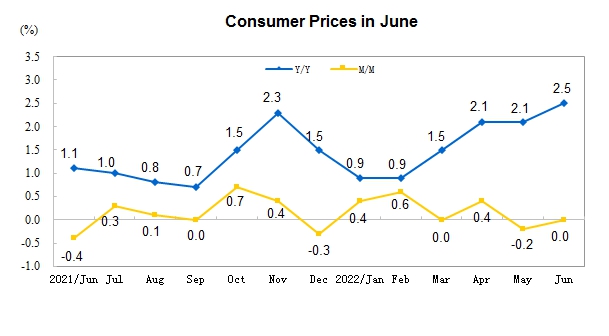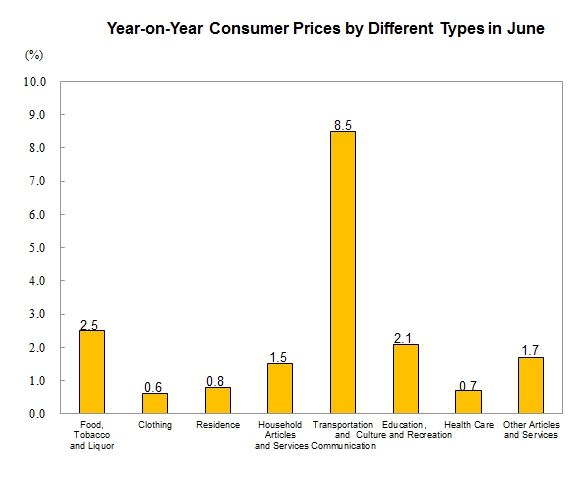Consumer Prices for June 2022
In June 2022, the national Consumer Price Index (CPI) rose by 2.5 percent year-on-year. Among them, the urban growth rate was 2.5 percent, and the rural growth rate was 2.6 percent; food prices rose by 2.9 percent, while nonfood prices rose by 2.5 percent; consumer goods prices rose by 3.5 percent and service prices rose by 1.0 percent. From January to June, on average, the national consumer price rose by 1.7 percent over the same period last year.
In June, the national consumer prices were flat month on month. Among them, the prices in urban and rural both unchanged; food prices fell by 1.6 percent, while nonfood prices rose by 0.4 percent; consumer goods prices fell by 0.1 percent and service prices rose by 0.2 percent.

I. Year-on-Year Changes of Prices of Different Categories
In June, the price of food, tobacco and alcohol increased by 2.5 percent year-on-year, affecting the CPI to rise by about 0.70 percentage point. Among foodstuff, the price of fresh fruit rose by 19.0 percent, affecting the CPI rise by about 0.34 percentage point; egg prices rose by 6.5 percent, affecting CPI growth by about 0.04 percentage point; fresh vegetable prices rose by 3.7 percent, affecting CPI growth by about 0.07 percentage point; grain prices rose by 3.2 percent, affecting CPI growth by about 0.06 percentage point; the price of livestock meat fell by 4.7 percent, affecting the CPI decline by about 0.16 percentage point, of which the price of pork fell by 6.0 percent, affecting the CPI decline by about 0.08 percentage point; the price of aquatic products fell by 3.3 percent, affecting the CPI to decline by about 0.07 percentage point.
The prices of the other seven categories rose year-on-year. Among them, the prices of transportation and communications, education, culture and entertainment, other supplies and services increased by 8.5, 2.1 and 1.7 percent respectively, the prices of daily necessities and services, housing increased by 1.5 and 0.8 percent respectively, and the prices of health care and clothing increased by 0.7 and 0.6 percent respectively.

II. Month-on-Month Changes of Prices of Different Categories
In June, the price of food, tobacco and alcohol decreased by 1.0 percent month on month, affecting the CPI to decline by about 0.28 percentage point. Among foodstuff, the price of fresh vegetables decreased by 9.2 percent, which affected the CPI decline by about 0.19 percentage point; fresh fruit prices fell by 4.5 percent, affecting CPI down by about 0.10 percentage point; egg prices fell by 4.3 percent, affecting CPI down by about 0.03 percentage point; the price of aquatic products fell by 1.6 percent, affecting the CPI to decline by about 0.03 percentage point; the price of livestock meat rose by 1.0 percent, affecting the CPI rise by about 0.03 percentage point, of which the price of pork rose by 2.9 percent, affecting the CPI rise by about 0.04 percentage point.
The prices of the other seven major categories rose three, leveled two and fell two month on month. Among them, the prices of transportation and communications, education, culture and entertainment, other supplies and services increased by 2.2, 0.1 and 0.1 percent respectively; housing and health care prices were flat; the prices of daily necessities and services and clothing decreased by 0.2 and 0.1 percent respectively.

Consumer Prices in June 2022
|
|
M/M (%) |
Y/Y (%) |
Jan-Jun |
|
Growth Rate(%) |
|||
|
|
|
|
|
|
Consumer Prices |
0.0 |
2.5 |
1.7 |
|
Of which: Urban |
0.0 |
2.5 |
1.7 |
|
Rural |
0.0 |
2.6 |
1.5 |
|
Of which: Food |
-1.6 |
2.9 |
-0.4 |
|
Non food |
0.4 |
2.5 |
2.2 |
|
Of which: Consumer Goods |
-0.1 |
3.5 |
2.1 |
|
Services |
0.2 |
1.0 |
1.1 |
|
Of which: Excluding Food and Energy |
0.1 |
1.0 |
1.0 |
|
By Commodity Categories |
|
|
|
|
I. Food, Tobacco and Liquor |
-1.0 |
2.5 |
0.4 |
|
Grain |
0.0 |
3.2 |
2.4 |
|
Cooking Oil |
1.4 |
5.0 |
3.9 |
|
Fresh Vegetables |
-9.2 |
3.7 |
8.0 |
|
Meat |
1.0 |
-4.7 |
-19.7 |
|
Of which: Pork |
2.9 |
-6.0 |
-33.2 |
|
Beef |
-0.4 |
0.9 |
0.5 |
|
Mutton |
-1.6 |
-6.0 |
-4.6 |
|
Aquatic Products |
-1.6 |
-3.3 |
2.4 |
|
Eggs |
-4.3 |
6.5 |
6.7 |
|
Dairy products |
0.2 |
0.9 |
0.7 |
|
Fresh Fruits |
-4.5 |
19.0 |
12.0 |
|
Tobacco |
0.1 |
1.5 |
1.7 |
|
Liquor |
0.4 |
1.6 |
1.7 |
|
II. Clothing |
-0.1 |
0.6 |
0.5 |
|
Clothing |
-0.1 |
0.7 |
0.6 |
|
Shoes |
-0.1 |
0.5 |
0.2 |
|
III. Residence |
0.0 |
0.8 |
1.2 |
|
House Renting |
0.1 |
-0.3 |
0.1 |
|
Water, Electricity, and Fuel |
-0.3 |
4.0 |
4.0 |
|
IV. Household Articles and Services |
-0.2 |
1.5 |
1.0 |
|
Household Appliances |
-0.8 |
1.3 |
1.9 |
|
Household Services |
0.2 |
2.7 |
3.0 |
|
V. Transportation and Communication |
2.2 |
8.5 |
6.3 |
|
Transportation Facilities |
-0.3 |
0.2 |
0.6 |
|
Fuels for Vehicles |
6.6 |
32.8 |
26.2 |
|
Vehicle Use and Maintenance |
-0.1 |
1.5 |
1.5 |
|
Communication Facilities |
-0.9 |
-4.3 |
-3.5 |
|
Communication Services |
-0.1 |
-0.3 |
-0.3 |
|
Postal Services |
0.0 |
0.0 |
-0.2 |
|
VI. Education, Culture and Recreation |
0.1 |
2.1 |
2.3 |
|
Education Services |
0.0 |
2.5 |
2.6 |
|
Tourism |
1.2 |
4.1 |
4.4 |
|
VII. Health Care |
0.0 |
0.7 |
0.7 |
|
Traditional Chinese Medicines |
0.3 |
2.7 |
2.2 |
|
Western Medicines |
0.1 |
-0.4 |
-0.5 |
|
Health Care Services |
0.0 |
0.9 |
0.9 |
|
VIII. Other Articles and Services |
0.1 |
1.7 |
1.2 |
|
|
|
|
|
Annotations:
1. Explanatory Notes
Consumer Price Index (CPI) is an index measuring changes over time in the price level of consumer goods and services purchased by residents, which comprehensively reflects the changes of price level.
2. Statistical Coverage
Consumer Price Index (CPI) covers the prices of goods and services of 8 categories and 268 basic divisions which cover the living consumption of urban and rural residents, including food, tobacco and liquor; clothing; residence; household articles and services; transportation and communication; education, culture and recreation; health care; other articles and services.
3. Survey Methods
According to the principle of "fixed person, fixed point and fixed time", people are directly sent to the survey sites or collect the original price from the Internet. The data comes from about 500 cities and counties in 31 provinces (autonomous regions and cities) and nearly 100,000 price survey points, including shopping malls (stores), supermarkets, farmers' markets, service outlets and Internet e-commerce.
4. Data Description
Due to "rounding-off", sometimes the aggregate data is the same as the high or low value of the classified data.
